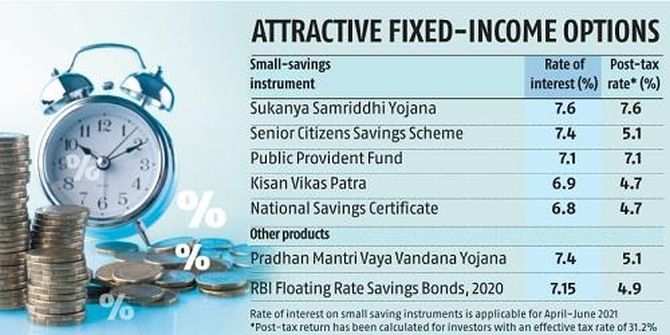'Decide on an asset allocation you are comfortable with and stick to it for the long term.'
Sanjay Kumar Singh reports.

The slashing of interest rates on small-savings instruments, and then the overnight reversal of the decision, has left investors bewildered.
It has also led many to believe that the respite may only be temporary.
Cuts are likely
Most experts, too, believe it is only a matter of time before small-savings instruments' above-market returns are pruned.
Says Ankur Maheshwari, chief executive officer, Equirus Wealth Management: "The government wants lower interest rates within the economy. The existing rates have been retained for only a quarter, so they may be reconsidered once that period is over, or a little later."
The Shyamala Gopinath Committee had earlier created a framework for deciding small-savings rates.
According to it, the average yield on government securities (G-Secs) of a similar maturity should be calculated over the previous year, and then a 25-basis point spread should be offered above it.
"Since a mechanism for aligning small-savings rates with market rates already exists, it is only a matter of time before it is fully implemented," says Vishal Dhawan, chief financial planner, Plan Ahead Wealth Advisors.
Factor in real returns
Experts say that even if rates are cut, things will actually not be so bad if investors consider the real rate of return, instead of just the nominal rate.
Consumer Price Index-based inflation has averaged 3.9 per cent between October and March.
"An above 6 per cent rate would still be attractive and investors should comfortable holding some of these instruments. It is no different than getting a return of, say, 12 per cent when inflation is at 10 per cent," says Ankur Kapur, managing partner, Plutus Capital, a Sebi-registered investment advisory firm.
Investors, however, need to diversify beyond a pure fixed-income portfolio.
"Decide on an asset allocation you are comfortable with and stick to it for the long term," says Kapur.

Go for the best rates
Maheshwari says that with the government intent on keeping interest rates at current levels or pushing them lower, it makes sense to invest in the instruments offering the most attractive rates.
Any decision regarding where to invest should be based on prevailing rates.
Says Dhawan: "Do not act based on guesswork regarding what the rates could be three-six months later. If you find a product attractive currently, invest in it."
While small-savings rates are higher than prevailing market rates, Dhawan points out that rates have also been hardening both in India and globally.
So, predicting either the timing or the quantum of rate cuts is impossible.
Factor in liquidity
Begin by comparing post-tax return (please see table).
Only returns from Public Provident Fund (PPF) and Sukanya Samriddhi Yojana (SSY) are tax-free.
Next, consider liquidity -- whether you can afford to keep your money locked in for the long periods required by many of the instruments that offer higher returns.
Some of the products that offer the best rates -- SSY and Senior Citizens Savings Scheme (SCSS) -- are open only to specific groups like parents of a girl child below 10 and senior citizens, respectively.
Only some of the small-savings instruments allow you to lock in the current interest rates for a considerable period.
SCSS, National Savings Certificate (NSC), Kisan Vikas Patra (KVP) and the time deposits allow it; rates of the rest are subject to periodic revision.
Finally, remember there is an investment cap on many of these products.
Next, let us discuss some of the small-savings options that are attractive for higher-income earners.
PPF
Its attractiveness has gone up, especially with interest income from Employee Provident Fund on contributions above Rs 2.5 lakh being made taxable.
"The 7.1 per cent tax-free interest rate makes it very attractive. Your investment is also eligible for Section 80C deduction," says Raghvendra Nath, managing director, Ladderup Wealth.
However, the rate of return is subject to revision.
You can only invest Rs 1.5 lakh per person per year.
A family of two adults and two minors can invest Rs 3 lakh per year.
Contributions to minors' accounts get clubbed with adults' contributions.
Also, you need an investment horizon of 15 years (partial withdrawal up to 50 per cent is allowed after six years).
Sukanya Samriddhi Yojana (SSY):
It offers the highest rate of return of 7.6 per cent, which is tax-free.
This rate, too, is subject to revision. Investment is capped at Rs 1.5 lakh per year per girl child.
Conditions for withdrawal are, however, restrictive.
The first withdrawal (up to 50 per cent of the balance available at the end of the preceding financial year) can only happen after the child has turned 18 or passed the 10th standard.
The final withdrawal can happen 21 years from the date of account opening.
If your daughter was five when the account was opened, you can withdraw the entire money when she turns 26, or earlier at the time of her marriage, provided she is 18 by then.
Senior Citizens Savings Scheme (SCSS):
It has an attractive rate of return of 7.4 per cent, which you can lock in for five years.
Senior citizens get Section 80C benefit on investing.
But the interest earned is taxable. It pays quarterly interest, a boon for retirees who need regular cash flows.
The investment limit is Rs 15 lakh per person or Rs 30 lakh for a couple.
"The elderly who have adequate emergency money should use this instrument to the hilt," says Maheshwari.
Next comes KVP, which offers 6.9 per cent interest (taxable).
But it has a long lock-in of 124 months. NSC offers 6.8 per cent (taxable).
The interest earned in the current year gets reinvested and offers tax benefit under Section 80C next year.
Among other government-backed schemes, consider the RBI Floating Rate Savings Bond, 2020, which pays 7.15 per cent (taxable) and has a seven-year lock-in.
Its return is linked to the NSC (35 basis points above it).
Senior citizens should also consider the Pradhan Mantri Vaya Vandana Yojana, which pays 7.4 per cent return (taxable) currently, subject to revision every year. Seniors can lock in rates for 10 years.











 © 2025
© 2025